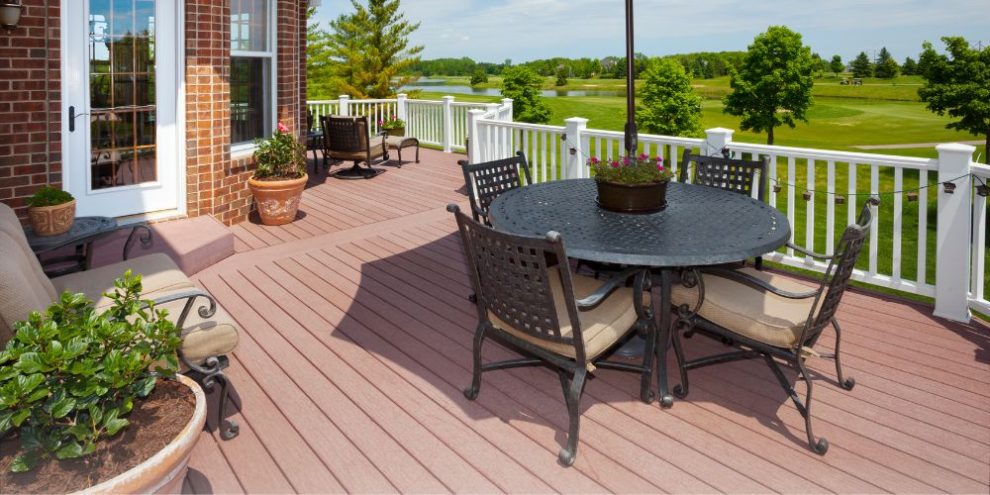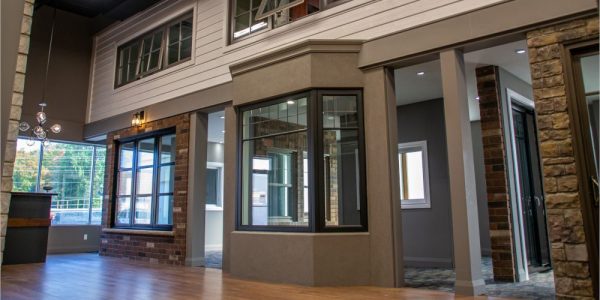
This Barrie 360 article is brought to you by United Lumber Home Hardware
Deciding between a deck and a patio can be a tough call.
Both offer fantastic ways to expand your living space and enjoy the outdoors. But with key differences in construction, maintenance, and overall feel, the ideal choice depends on your specific needs and preferences.
We had a chance to speak with Rob Markham, United Lumber's Deck Department Coordinator, about decks, patios and how to choose between the two. Here's everything we learned ...
The key differences between decks and patios
The most fundamental difference between decks and patios lies in their connection to the ground.
Decks are elevated platforms typically constructed with wood, composite materials, or even metal. They can range from a few feet off the ground to multi-level structures. Rob explains that the lowest a deck can be built is 7" above grade.
Decks excel in areas with scenic overlooks, allowing you to take in unobstructed views of the surrounding landscape. They’re also great for properties with uneven terrain or doors that aren’t level with the ground.
RELATED: What you need to know about building a deck ...
Patios, on the other hand, create a natural extension of your home's living space, offering a smooth transition between indoor and outdoor environments. This easy access makes them ideal for entertaining and creating a cohesive indoor-outdoor feel.
While they are usually built at ground-level with stamped concrete, pavers, stone, or brick, patios can have multiple levels just like decks. Rob explains, "A patio can be raised if the property’s grade calls for multi-levels. This is known as 'hardscape' whereby large, quarried rock of various sizes and thicknesses are utilized to create steps and retaining walls of varying levels. These walls are then backfilled with compacted soil or aggregate. The different level areas are then capped with the stamped concrete and or decorative pavers and patio stones."
Rob goes on to share that there are no real advantages of one over the other. "It comes down to functionality, what area/space available to work with and what 'interferences' are present. There can be many interferences, such as septic beds, a steep grade to your property or a door that is several feet from ground level."
Still, decks and patios do have some key differences that you should know about before choosing to build either ...
A better look at decks
Like any home improvement project, decks come with both advantages and disadvantages. Here, we'll take a balanced look at both the pros and cons to help you decide if a deck is the perfect addition to your backyard.
Advantages of decks
Here are some of the many reasons why a deck might be the right choice for your dream outdoor retreat …
1. Unobstructed views
As mentioned before, decks are perfect for enjoying great views. The elevation allows you to take in the full beauty of your surroundings, whether it's a sprawling landscape, a sunset view, or simply overlooking your own backyard.
2. Increased usable space
A well-designed deck can feel like an extension of your home, but with a unique open-air atmosphere. This creates a special space for relaxing, entertaining, or simply enjoying the fresh air.
Better yet, decks help make living space out of otherwise undesirable terrain that is sloped or uneven. This isn’t something that’s easily achieved with patios.
3. Versatility in design and customization
Decks offer a wider range of design possibilities compared to patios. From single-level platforms to multi-level structures, you can incorporate stairs, railings, built-in seating, planters, pergolas, or even hot tubs to create a truly customized outdoor living space.
4. Increased home value
Studies have shown that decks can add significant value to a home, particularly in areas where outdoor living is a desirable feature. This can be a great return on investment if you ever decide to sell your house.
5. Potential for privacy
Depending on the design and placement of your deck, it can offer more privacy compared to a ground-level patio. This can be a benefit if your backyard is overlooked by neighbors or if you simply desire a more secluded outdoor space.
Disadvantages of decks
While decks offer undeniable advantages, it's important to approach any project with a clear understanding of the potential drawbacks. Here, we'll explore some of the considerations associated with decks to ensure you make an informed decision.
1. Higher cost
Decks typically involve more material and complex construction compared to patios. The additional posts, beams, and railings contribute to a generally higher upfront cost.
2. Safety concerns
Decks involve elevation, which introduces some safety considerations. Regular inspections and proper railing maintenance are essential to prevent accidents.
3. Weight limitations
Decks have weight limitations depending on the design and materials used. This is important to consider if you want to use the deck for heavy items like hot tubs or large outdoor furniture sets. The good news is, this disadvantage can be avoided with proper design and planning.
4. Susceptibility to rot and insect damage
Wood decks, in particular, are susceptible to rot and insect damage if not properly maintained. Choosing pressure-treated wood and applying sealants regularly can help mitigate these risks.
5. Maintenance requirements
Regular maintenance is crucial, especially for wooden decks. This includes staining, cleaning, and inspecting for potential damage to ensure the deck remains safe and beautiful for years to come. (The next section will talk about maintenance in more detail.)
Keep in mind, many of these disadvantages can be avoided with proper planning, installation and maintenance. Material choice also has a huge impact.
"Maintenance can be made easier on decks by building with composite or PVC decking and installing aluminum railings, both of which are now more popular that 100% wooden decks and railings." Rob explains. These materials can also help reduce the risk of rot, insect damage and more.
What’s involved in maintaining a deck
Here's a breakdown of the key maintenance tasks for decks:
Sweeping
Regularly sweeping your deck removes leaves, dirt, and debris that can trap moisture and accelerate wear. This is a simple yet effective way to extend the life of your deck.
Cleaning
A more thorough cleaning should be done annually. This involves removing dirt, debris, and mildew buildup. You can use a deck cleaning solution with a stiff brush and a light pressure wash.
Inspecting
Regularly inspect your deck for any signs of damage like warping, rot, or loose boards. Early detection allows you to address these issues promptly and prevent them from becoming bigger problems.
Staining or sealing
Staining your wood deck helps protect it from the elements, prevents moisture damage, and maintains its appearance. The frequency of staining or sealing depends on the type of stain or sealant used and your climate. Generally, reapplication is needed every 2 to 3 years.
RELATED: 7 tips for staining your deck ...
Minor repairs
Address any minor issues like loose screws or splintered wood promptly. Taking care of these small problems prevents them from turning into major repairs down the road.
Landscape management
Overhanging trees can block sunlight and keep your deck damp. Regularly trimming nearby trees allows for better air circulation and sunlight exposure.
Winterize your deck
In colder climates, remove any snow and ice buildup on your deck to prevent warping or cracking. You may also want to cover your deck with a breathable tarp during the winter months.
By following these maintenance practices, you can ensure your deck remains a beautiful and functional outdoor space.
A better look at patios
Patios provide a unique set of advantages, making them a popular choice for homeowners seeking easy access and a cohesive outdoor experience. However, just like decks, patios come with their own set of downfalls.
Let’s dive into both that advantages and disadvantages of patios:
Advantages of patios
Here's a closer look at the many benefits patios bring:
1. Easy access and flow
A major benefit of patios is the seamless connection they create between your indoor and outdoor living areas. Stepping out onto a patio feels natural, making it perfect for entertaining or simply extending your living space outdoors.
2. Low maintenance
Compared to decks, especially wood decks that require regular staining and maintenance, patios generally require less upkeep. Depending on the material, they might only need occasional cleaning and minimal repairs, saving you time and effort in the long run.
3. Cost-effective
Since patios use less material and don't require complex construction like posts or beams, they are typically a more budget-friendly option compared to decks. This can be a deciding factor for homeowners looking to maximize their outdoor enjoyment without breaking the bank.
4. Versatility in design
While they may not offer the same flexibility of decks, patios can still be quite versatile in design. You can incorporate features like built-in seating, fire pits, pergolas, or planters to create a customized and inviting outdoor space.
5. Usable for all ages and abilities
The ground-level nature of patios makes them easily accessible for everyone. This is a significant advantage for those with mobility limitations or who simply prefer a more accessible outdoor space.
Disadvantages of patios
While patios offer several advantages, it's important to consider some potential drawbacks before making your final decision.
Here's a look at some of the factors to keep in mind:
1. Limited drainage
Patios can often have drainage issues. Improper drainage can lead to water pooling, creating a mosquito haven and causing the patio surface to deteriorate faster over time. If your patio is close to your home, it can also lead to issues with your foundation.
2. Susceptibility to Canadian weather
Patios are more prone to the effects of extreme weather. Freezing temperatures can cause heaving or cracking in some patio materials, particularly if the sub-base wasn't properly prepared. Additionally, hot sun can radiate intense heat, making the patio surface uncomfortable to walk on barefoot.
3. Less usable space
Since they are built around existing ground level, patios may not be ideal for utilizing the entire outdoor space. Uneven backyards might require significant excavation or grading to create a large, level patio, adding to the cost and complexity of the project.
Keep in mind that while there can be disadvantages to patio, many can be avoided with proper planning, installation and maintenance.
What’s involved in maintaining a patio
Maintaining a patio is generally less demanding compared to decks, but there are still some regular chores to ensure it remains in great condition. Here's what's involved:
Sealing
Like wood, patio materials benefit from periodic sealing. Sealing helps repel water, prevents staining, makes it easier to remove algae and debris, and maintains the overall look of the patio. While the frequency of resealing depends on the material, climate, and wear-and-tear, you generally need to reapply sealer every few years.
Cleaning
Regular cleaning is essential to remove dirt, debris, and surface grime. The cleaning frequency depends on the material and how often you use your patio. For most patios, sweeping weekly and a more thorough cleaning in the spring and fall is sufficient.
If you build with concrete or pavers, you can use a broom, water hose, and mild detergent solution.
For natural stone patios, a special stone cleaner might be needed to avoid damaging the surface.
Weed control
Patios are notorious for having weeds grow between the cracks. Regularly removing weeds helps maintain a neat appearance and prevents them from spreading. You can use a weed removal tool, natural weed control methods, or a targeted herbicide specific to your patio material.
To help minimize weeds, be sure to add a weed barrier beneath the patio when installing it.
Adding sand
Over time, the sand between pavers can settle or wash away. For paver patios, periodic re-sanding is needed to fill gaps and maintain a level surface. This typically involves sweeping the patio clean, applying polymeric sand between the pavers, and then watering it to settle the sand.
Regular inspections
Look for any cracks, loose pavers, or signs of wear and tear during your regular cleaning routine. Addressing minor issues promptly prevents them from becoming bigger problems down the line.
Winter maintenance
In colder climates, removing snow and ice buildup is important to prevent cracking or damage to the patio surface. You may also want to cover your patio with a tarp during harsh winter weather conditions.
By following these simple maintenance practices, you can ensure your patio looks good for years to come.
Common mistakes to avoid
Whether you're building a deck or patio, there are many common mistakes homeowners make. Knowing what these are before you build will help you avoid bigger problems in the future.
Mistakes people make when building a deck
Here are some common mistakes people make when building a deck:
Putting Form before function
Having been in the construction industry for many years, Rob explains that the biggest mistake he sees people make is putting form before function.
"Too many people see a deck on Pinterest, or some other website, that looks beautiful but will not fit the actual use of their deck." Rob continues, saying "When planning a deck consider what you are going to be doing on it. How many guests are you going to be entertaining. How much seating do you need? Do you want people to be able to pass by each other on the stairs? Are there small children in the family or as regular guests? Are you going to be cooking and preparing food on your deck? Do you want shade? Do you want privacy? Make a list of what you want out of your deck and design around these. Do that, and your deck will come out beautiful."
Improper ledger board attachment
The ledger board is a crucial connection point between the deck and your house. Incorrectly attaching it can lead to major safety hazards. When building your deck, make sure it's securely fastened to the house structure using the proper bolts or lags, not just nails.
Skipping permits
Depending on your local regulations and the size and height of your deck, you might need a permit before construction. Failing to obtain the necessary permits can result in fines or even force you to dismantle the deck.
Ignoring weight limits
Not considering the weight of furniture, hot tubs, or large planters can lead to structural issues and potential safety hazards. Always design your deck with the intended purpose in mind to reduce damage and potential injury.
Using the wrong fasteners
There are specific types of fasteners designed for deck construction. Using the wrong screws, nails, or bolts can compromise the structural integrity of the deck and lead to future problems.
Incorrect joist spacing
Floor joists provide crucial support for the deck surface. Improper spacing can lead to a bouncy or uneven deck, and in extreme cases, even collapse. Always follow recommended joist spacing based on the size of the deck and the material used.
Neglecting drainage
Proper drainage is essential to prevent water from pooling on the deck surface or beneath it. Ensure your deck design incorporates proper sloping and flashing to direct water away from the structure.
Choosing the wrong decking material
Decking materials come in various options, each with its own advantages and drawbacks. Consider factors like durability, maintenance requirements, and budget when selecting your decking material. Pressure-treated lumber is a popular choice, but composite decking offers lower maintenance needs.
Failing to account for future maintenance
Decks, especially wooden decks, require regular maintenance like staining and cleaning. Plan for this ongoing maintenance when making your decision and choose materials that fit your comfort level with upkeep.
Rushing the project
Building a deck requires careful planning and execution. Don't rush the process to avoid cutting corners or overlooking important details that could impact the safety and longevity of your deck.
DIY without the right skills
While some people are incredibly handy and can tackle deck building themselves, it's a complex project. If you lack the necessary skills or experience, consider hiring a professional deck builder to ensure a safe and structurally sound outcome.
Common mistakes when building a patio
Here are some common mistakes people make when building a patio:
Skimping on base preparation
A strong and stable base is crucial for a long-lasting patio. This involves proper excavation, leveling the ground, and installing a compacted gravel sub-base. Cutting corners on the base can lead to settling, unevenness, and cracking in the patio surface later down the road.
Ignoring drainage
Similar to decks, proper drainage is essential for patios. Without proper sloping and channeling of water away from the patio, water can pool and cause damage to the surface materials or create a breeding ground for mosquitoes.
Not considering future expansion
If you envision adding features like fire pits, pergolas, or outdoor kitchens in the future, factor that into your initial design. Leaving enough space and considering future access points can prevent the need for costly modifications later.
Choosing the wrong material
Patios come in various materials like concrete, pavers, natural stone, or even stamped concrete. Each material has its own advantages and disadvantages in terms of durability, maintenance, and aesthetics. Select a material that suits your budget, desired look, and the amount of traffic the patio will experience.
Matching patio exactly to house lines
While creating a cohesive look is important, avoid rigidly matching the straight lines of your house with the patio. A slight curve or softened edges can add visual interest and make the patio feel like a more natural extension of your living space.
Forgetting about transitions
The transition between the patio and your house or other landscape features needs careful consideration. Installing edging or using materials that create a smooth and visually appealing transition prevents a disconnected look.
Not thinking about the sun
Consider the amount of sun exposure your patio will receive throughout the day. If it gets intense afternoon sun, incorporating shade elements like pergolas or awnings can make the space more comfortable during hot summer days.
Forgetting joint filling
For patios using pavers, gravel, or stones, proper filling of the gaps between the materials is crucial. Using polymeric sand or recommended fillers ensures stability, prevents weeds from growing through, and maintains a clean, finished look.
DIY without proper knowledge
While patios can be DIY projects, it's important to have the necessary knowledge and skills. Understanding proper base preparation, leveling techniques, and material installation methods is crucial for a successful and long-lasting patio.
By being aware of these common mistakes and taking the time to plan and execute your deck project carefully, you can avoid costly repairs and ensure you end up with a beautiful and functional outdoor space you can enjoy for years to come.
RELATED: Creative deck ideas to enhance your outdoor space ...
Choosing to go with a deck AND a patio
Combining decks and patios can create a truly unique and functional outdoor living space that leverages the strengths of both options. Here are some scenarios where you might consider both:
Multi-level backyards
If your backyard has multiple levels or changes in elevation, incorporating both a deck and a patio can create a cohesive design. A deck on a higher level can offer scenic views, while a patio on a lower level creates easy access and additional entertaining space.
Zoning different areas
Combining a deck and a patio allows you to zone your outdoor space for different purposes. For example, you could have a deck with a seating area for relaxing and enjoying the views, while the patio could be designated for grilling and food prep.
Creating a gradual transition
The combination of a deck and patio can create a beautiful and natural transition between your home and the backyard. The deck can act as a bridge, connecting the higher elevation of your house to the ground-level patio, offering a smooth flow between indoor and outdoor living.
Addressing specific needs
Perhaps you crave the elevated views and unique space of a deck but also desire the easy access that a patio provides for a lover one with mobility issues. Combining both elements allows you to fulfill all your needs and create a truly versatile outdoor haven.
Aesthetics and personal preference
Some homeowners simply prefer the visual appeal of having both a deck and a patio. The combination can add depth and dimension to your outdoor space, creating a visually interesting and inviting environment.
Of course, this approach requires careful planning and design to ensure a cohesive look and functionality. Consulting with a landscape designer can help you explore the possibilities and create a design that perfectly blends a deck and patio to suit your unique needs and backyard layout.
The Final Choice: It's All About You
At the end of the day, the ideal choice boils down to your priorities, preference, and what your property will allow.
Whatever why you choose to go, by considering the factors above and planning ahead, you'll be well-equipped to create your dream outdoor retreat.












